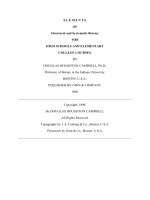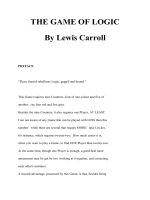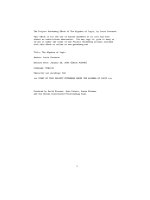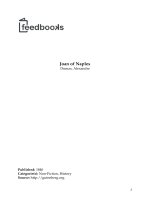Elements of Chemistry,, by Antoine Lavoisier doc
Bạn đang xem bản rút gọn của tài liệu. Xem và tải ngay bản đầy đủ của tài liệu tại đây (3.85 MB, 1,156 trang )
The Project Gutenberg EBook of Elements of
Chemistry,, by Antoine Lavoisier
This eBook is for the use of anyone
anywhere at no cost and with
almost no restrictions whatsoever. You may
copy it, give it away or
re-use it under the terms of the Project
Gutenberg License included
with this eBook or online at
www.gutenberg.net
Title: Elements of Chemistry,
In a New Systematic Order, Containing all
the Modern Discoveries
Author: Antoine Lavoisier
Translator: Robert Kerr
Release Date: December 28, 2009 [EBook
#30775]
Language: English
*** START OF THIS PROJECT GUTENBERG EBOOK
ELEMENTS OF CHEMISTRY, ***
Produced by Mark C. Orton, Josephine
Paolucci and the
Online Distributed Proofreading Team at
ELEMENTS
OF
CHEMISTRY,
IN A
NEW SYSTEMATIC
ORDER,
CONTAINING ALL THE
MODERN DISCOVERIES.
ILLUSTRATED WITH
THIRTEEN
COPPERPLATES.
By Mr LAVOISIER,
Member of the Academy of Sciences,
Royal Society of Medicine, and
Agricultural Society of Paris, of the Royal
Society of London, and Philosophical
Societies of Orleans, Bologna, Basil,
Philadelphia, Haerlem, Manchester, &c.
&c.
TRANSLATED FROM THE
FRENCH,
By ROBERT KERR,
F.R. & A.SS.E.
Member of the Royal College of
Surgeons, and Surgeon to the Orphan
Hospital of Edinburgh.
EDINBURGH: printed for WILLIAM
CREECH, and sold in london by g. g. and
j. j. robinsons.
MDCCXC.
ADVERTISEMENT
OF THE
TRANSLATOR.
The very high character of Mr Lavoisier
as a chemical philosopher, and the great
revolution which, in the opinion of many
excellent chemists, he has effected in the
theory of chemistry, has long made it much
desired to have a connected account of his
discoveries, and of the new theory he has
founded upon the modern experiments
written by himself. This is now
accomplished by the publication of his
Elements of Chemistry; therefore no
excuse can be at all necessary for giving
the following work to the public in an
English dress; and the only hesitation of
the Translator is with regard to his own
abilities for the task. He is most ready to
confess, that his knowledge of the
composition of language fit for publication
is far inferior to his attachment to the
subject, and to his desire of appearing
decently before the judgment of the world.
He has earnestly endeavoured to give the
meaning of the Author with the most
scrupulous fidelity, having paid infinitely
greater attention to accuracy of translation
than to elegance of stile. This last indeed,
had he even, by proper labour, been
capable of attaining, he has been obliged,
for very obvious reasons, to neglect, far
more than accorded with his wishes. The
French copy did not reach his hands
before the middle of September; and it
was judged necessary by the Publisher
that the Translation should be ready by the
commencement of the University Session
at the end of October.
He at first intended to have changed all the
weights and measures used by Mr
Lavoisier into their correspondent English
denominations, but, upon trial, the task
was found infinitely too great for the time
allowed; and to have executed this part of
the work inaccurately, must have been
both useless and misleading to the reader.
All that has been attempted in this way is
adding, between brackets ( ), the degrees
of Fahrenheit's scale corresponding with
those of Reaumeur's thermometer, which
is used by the Author. Rules are added,
however, in the Appendix, for converting
the French weights and measures into
English, by which means the reader may at
any time calculate such quantities as
occur, when desirous of comparing Mr
Lavoisier's experiments with those of
British authors.
By an oversight, the first part of the
translation went to press without any
distinction being preserved between
charcoal and its simple elementary part,
which enters into chemical combinations,
especially with oxygen or the acidifying
principle, forming carbonic acid. This
pure element, which exists in great plenty
in well made charcoal, is named by Mr
Lavoisier carbone, and ought to have been
so in the translation; but the attentive
reader can very easily rectify the mistake.
There is an error in Plate XI. which the
engraver copied strictly from the original,
and which was not discovered until the
plate was worked off at press, when that
part of the Elements which treats of the
apparatus there represented came to be
translated. The two tubes 21. and 24. by
which the gas is conveyed into the bottles
of alkaline solution 22. 25. should have
been made to dip into the liquor, while the
other tubes 23. and 26. which carry off the
gas, ought to have been cut off some way
above the surface of the liquor in the
bottles.
A few explanatory notes are added; and
indeed, from the perspicuity of the Author,
very few were found necessary. In a very
small number of places, the liberty has
been taken of throwing to the bottom of the
page, in notes, some parenthetical
expressions, only relative to the subject,
which, in their original place, tended to
confuse the sense. These, and the original
notes of the Author, are distinguished by
the letter A, and to the few which the
Translator has ventured to add, the letter E
is subjoined.
Mr Lavoisier has added, in an Appendix,
several very useful Tables for facilitating
the calculations now necessary in the
advanced state of modern chemistry,
wherein the most scrupulous accuracy is
required. It is proper to give some account
of these, and of the reasons for omitting
several of them.
No. I. of the French Appendix is a Table
for converting ounces, gros, and grains,
into the decimal fractions of the French
pound; and No. II. for reducing these
decimal fractions again into the vulgar
subdivisions. No. III. contains the number
of French cubical inches and decimals
which correspond to a determinate weight
of water.
The Translator would most readily have
converted these Tables into English
weights and measures; but the necessary
calculations must have occupied a great
deal more time than could have been
spared in the period limited for
publication. They are therefore omitted, as
altogether useless, in their present state, to
the British chemist.
No. IV. is a Table for converting lines or
twelfth parts of the inch, and twelfth parts
of lines, into decimal fractions, chiefly for
the purpose of making the necessary
corrections upon the quantities of gasses
according to their barometrical pressure.
This can hardly be at all useful or
necessary, as the barometers used in
Britain are graduated in decimal fractions
of the inch, but, being referred to by the
Author in the text, it has been retained, and
is No. I. of the Appendix to this
Translation.
No. V. Is a Table for converting the
observed heights of water within the jars
used in pneumato-chemical experiments
into correspondent heights of mercury for
correcting the volume of gasses. This, in
Mr Lavoisier's Work, is expressed for the
water in lines, and for the mercury in
decimals of the inch, and consequently, for
the reasons given respecting the Fourth
Table, must have been of no use. The
Translator has therefore calculated a
Table for this correction, in which the
water is expressed in decimals, as well as
the mercury. This Table is No. II. of the
English Appendix.
No. VI. contains the number of French
cubical inches and decimals contained in
the corresponding ounce-measures used in
the experiments of our celebrated
countryman Dr Priestley. This Table,
which forms No. III. of the English
Appendix, is retained, with the addition of
a column, in which the corresponding
English cubical inches and decimals are
expressed.
No. VII. Is a Table of the weights of a
cubical foot and inch, French measure, of
the different gasses expressed in French
ounces, gros, grains, and decimals. This,
which forms No. VI. of the English
Appendix, has been, with considerable
labour, calculated into English weight and
measure.
No. VIII. Gives the specific gravities of a
great number of bodies, with columns,
containing the weights of a cubical foot
and inch, French measure, of all the
substances. The specific gravities of this
Table, which is No. VII. of the English
Appendix, are retained, but the additional
columns, as useless to the British
philosopher, are omitted; and to have
converted these into English
denominations must have required very
long and painful calculations.
Rules are subjoined, in the Appendix to
this translation, for converting all the
weights and measures used by Mr
Lavoisier into corresponding English
denominations; and the Translator is
proud to acknowledge his obligation to the
learned Professor of Natural Philosophy
in the University of Edinburgh, who kindly
supplied him with the necessary
information for this purpose. A Table is
likewise added, No. IV. of the English
Appendix, for converting the degrees of
Reaumeur's scale used by Mr Lavoisier
into the corresponding degrees of
Fahrenheit, which is universally employed
in Britain
[1]
.
This Translation is sent into the world
with the utmost diffidence, tempered,
however, with this consolation, that,
though it must fall greatly short of the
elegance, or even propriety of language,
which every writer ought to endeavour to
attain, it cannot fail of advancing the
interests of true chemical science, by
disseminating the accurate mode of
analysis adopted by its justly celebrated
Author. Should the public call for a
second edition, every care shall be taken
to correct the forced imperfections of the
present translation, and to improve the
work by valuable additional matter from
other authors of reputation in the several
subjects treated of.
Edinburgh, }
Oct. 23. 1789. }
FOOTNOTES:
The Translator has since been enabled,
by the kind assistance of the gentleman
above alluded to, to give Tables, of the
same nature with those of Mr
Lavoisier, for facilitating the
calculations of the results of chemical
experiments.
PREFACE OF THE
AUTHOR.
When I began the following Work, my
only object was to extend and explain
more fully the Memoir which I read at the
public meeting of the Academy of
Sciences in the month of April 1787, on
the necessity of reforming and completing
the Nomenclature of Chemistry. While
engaged in this employment, I perceived,
better than I had ever done before, the
justice of the following maxims of the
Abbé de Condillac, in his System of
Logic, and some other of his works.
"We think only through the medium of
words.—Languages are true analytical
methods.—Algebra, which is adapted to
its purpose in every species of expression,
in the most simple, most exact, and best
manner possible, is at the same time a
language and an analytical method.—The
art of reasoning is nothing more than a
language well arranged."
Thus, while I thought myself employed
only in forming a Nomenclature, and
while I proposed to myself nothing more
than to improve the chemical language, my
work transformed itself by degrees,
without my being able to prevent it, into a
treatise upon the Elements of Chemistry.
The impossibility of separating the
nomenclature of a science from the
science itself, is owing to this, that every
branch of physical science must consist of
three things; the series of facts which are
the objects of the science, the ideas which
represent these facts, and the words by
which these ideas are expressed. Like
three impressions of the same seal, the
word ought to produce the idea, and the
idea to be a picture of the fact. And, as
ideas are preserved and communicated by
means of words, it necessarily follows
that we cannot improve the language of
any science without at the same time
improving the science itself; neither can
we, on the other hand, improve a science,
without improving the language or
nomenclature which belongs to it.
However certain the facts of any science
may be, and, however just the ideas we
may have formed of these facts, we can
only communicate false impressions to
others, while we want words by which
these may be properly expressed.
To those who will consider it with
attention, the first part of this treatise will
afford frequent proofs of the truth of the
above observations. But as, in the conduct
of my work, I have been obliged to
observe an order of arrangement
essentially differing from what has been
adopted in any other chemical work yet
published, it is proper that I should
explain the motives which have led me to
do so.
It is a maxim universally admitted in
geometry, and indeed in every branch of
knowledge, that, in the progress of
investigation, we should proceed from
known facts to what is unknown. In early
infancy, our ideas spring from our wants;
the sensation of want excites the idea of
the object by which it is to be gratified. In
this manner, from a series of sensations,
observations, and analyses, a successive
train of ideas arises, so linked together,
that an attentive observer may trace back
to a certain point the order and connection
of the whole sum of human knowledge.
When we begin the study of any science,
we are in a situation, respecting that
science, similar to that of children; and the
course by which we have to advance is
precisely the same which Nature follows
in the formation of their ideas. In a child,
the idea is merely an effect produced by a









